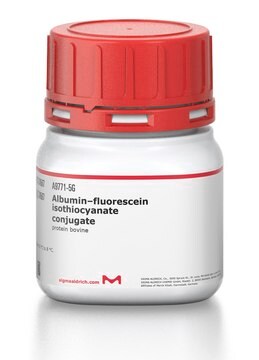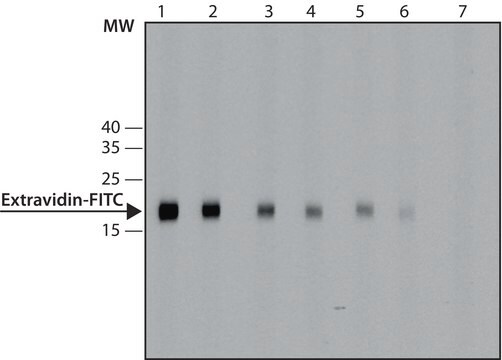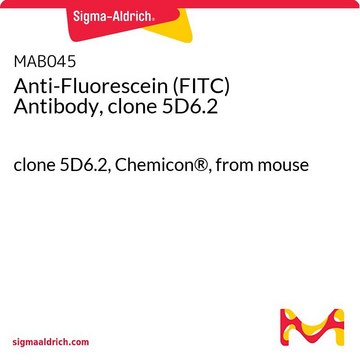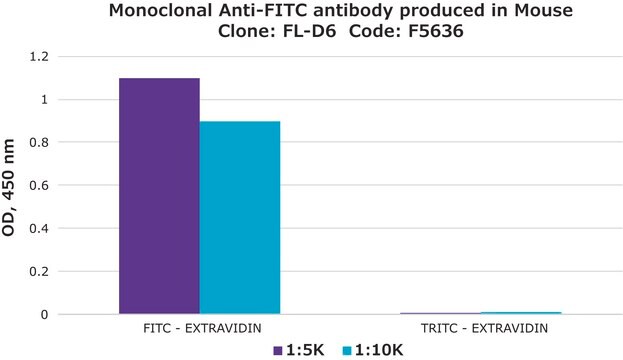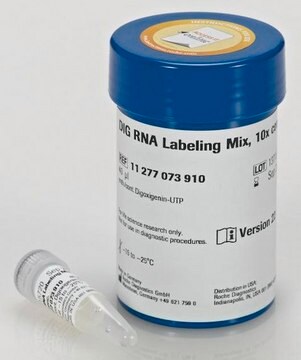SAB4600050
Monoclonal Anti-Fluorescein (FITC) IgG, CF™ 488A antibody produced in mouse
~2 mg/mL, clone 1F8.-1E4, purified immunoglobulin
Synonym(e):
Anti Fluorescein Antibody, Anti Fluorescein Antibody - Monoclonal Anti-Fluorescein (FITC) IgG, CF™488A antibody produced in mouse
About This Item
Empfohlene Produkte
Biologische Quelle
mouse
Qualitätsniveau
Konjugat
CF™ 488A conjugate
Antikörperform
purified immunoglobulin
Antikörper-Produkttyp
primary antibodies
Klon
1F8.-1E4, monoclonal
Form
buffered aqueous solution
Konzentration
~2 mg/mL
Methode(n)
indirect immunofluorescence: 1-10 μg/mL
Isotyp
IgG1κ
Fluoreszenz
λex 490 nm; λem 515 nm
Versandbedingung
dry ice
Lagertemp.
−20°C
Posttranslationale Modifikation Target
unmodified
Allgemeine Beschreibung
Spezifität
Immunogen
Anwendung
Biochem./physiol. Wirkung
CF™ dyes are a series of highly water-soluble fluorescent dyes, with wavelength extended over the visible and near-infrared (IR) spectrum for labeling biomolecules, mainly proteins and nucleic acids. The primary structure of the CF™ dyes is either cyanine dyes or rhodamine dyes. CF™ 633 produces the brightest antibody conjugates among spectrally similar dyes when excited by the 633nm He-Ne laser or the 635nm red diode laser. The most important advantage of CF™ 633 is its excellent photostability. The molecular weight of CF™ 633 is ~820 and its absorption/emission maxima are at 630/650nm.
Leistungsmerkmale und Vorteile
Physikalische Form
Angaben zur Herstellung
Rechtliche Hinweise
Haftungsausschluss
Sie haben nicht das passende Produkt gefunden?
Probieren Sie unser Produkt-Auswahlhilfe. aus.
Lagerklassenschlüssel
10 - Combustible liquids
WGK
WGK 2
Analysenzertifikate (COA)
Suchen Sie nach Analysenzertifikate (COA), indem Sie die Lot-/Chargennummer des Produkts eingeben. Lot- und Chargennummern sind auf dem Produktetikett hinter den Wörtern ‘Lot’ oder ‘Batch’ (Lot oder Charge) zu finden.
Besitzen Sie dieses Produkt bereits?
In der Dokumentenbibliothek finden Sie die Dokumentation zu den Produkten, die Sie kürzlich erworben haben.
Kunden haben sich ebenfalls angesehen
Unser Team von Wissenschaftlern verfügt über Erfahrung in allen Forschungsbereichen einschließlich Life Science, Materialwissenschaften, chemischer Synthese, Chromatographie, Analytik und vielen mehr..
Setzen Sie sich mit dem technischen Dienst in Verbindung.